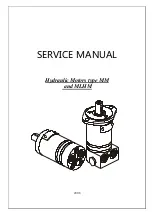
Pressurized water may also be used for cleaning.
The maximum water pressure for cleaning purposes
must be less than 275 kPa (40 psi). Use pressurized
water in order to soften mud. Clean the core from
both sides.
Use a degreaser and steam for removal of oil and
grease. Clean both sides of the core. Wash the core
with detergent and hot water. Thoroughly rinse the
core with clean water.
If the radiator is blocked internally, refer to the OEM
Manual for information regarding flushing the cooling
system.
After cleaning the radiator, start the engine. Allow the
engine to operate at low idle speed for three to five
minutes. Accelerate the engine to high idle. This will
help in the removal of debris and the drying of the
core. Slowly reduce the engine speed to low idle and
then stop the engine. Use a light bulb behind the core
in order to inspect the core for cleanliness. Repeat
the cleaning, if necessary.
Inspect the fins for damage. Bent fins may be opened
with a “comb”. Inspect these items for good condition:
Welds, mounting brackets, air lines, connections,
clamps and seals. Make repairs, if necessary.
i02177969
Starting
Motor
-
Inspect
Perkins
recommends
a
scheduled
inspection
of
the
starting
motor.
If
the
starting
motor
fails,
the
engine
may
not
start
in
an
emergency
situation.
Check
the
starting
motor
for
correct
operation.
Check
the
electrical
connections
and
clean
the
electrical
connections.
Refer
to
the
Systems
Operation,
Testing
and
Adjusting
Manual,
“Electric
Starting
System
-
Test”
for
more
information
on
the
checking
procedure
and
for
specifications
or
consult
your
Perkins
dealer
or
your
Perkins
distributor
for
assistance.
i06510382
Turbocharger
-
Inspect
A
regular
visual
inspection
of
the
turbocharger
is
recommended.
Any
fumes
from
the
crankcase
are
filtered
through
the
air
inlet
system.
Therefore,
byproducts
from
oil
and
from
combustion
can
collect
in
the
turbocharger
compressor
housing.
Over
time,
this
buildup
can
contribute
to
loss
of
engine
power,
increased
black
smoke
and
overall
loss
of
engine
efficiency.
If the turbocharger fails during engine operation,
damage to the turbocharger compressor wheel and/
or to the engine may occur. Damage to the
turbocharger compressor wheel can cause damageto
the pistons, the valves, and the cylinder head.
Refer to Systems Operation Testing and Adjusting,
Air Inlet and Exhaust System - Inspect and
Wastegate - Test for more information.
i06510405
Walk-Around
Inspection
Inspect
the
Engine
for
Leaks
and
for
Loose
Connections
A
walk-around
inspection
should
only
take
a
few
minutes.
When
the
time
is
taken
to
perform
these
checks,
costly
repairs
and
accidents
can
be
avoided.
For
maximum
engine
service
life,
make
a
thorough
inspection
of
the
engine
compartment
before
starting
the
engine.
Look
for
items
such
as
oil
leaks
or
coolant
leaks,
loose
bolts,
worn
belts,
loose
connections,
and
trash
buildup.
Make
repairs,
as
needed:
• The guards must be in the correct place. Repair
damaged guards or replace missing guards.
• Wipe all caps and plugs before the engine is
serviced to reduce the chance of system
contamination.
NOTICE
For any type of leak (coolant, lube, or fuel) clean up
the fluid. If leaking is observed, find the source and
correct the leak. If leaking is suspected, check the flu-
id levels more often than recommended until the leak
is found or fixed, or until the suspicion of a leak is
proved to be unwarranted.
NOTICE
Accumulated grease and/or oil on an engine is a fire
hazard. Remove the accumulated grease and oil. Re-
fer to this Operation and Maintenance Manual, “En-
gine - Clean” for more information.
• Ensure that the cooling system hoses are correctly
clamped and that the cooling system hoses are
tight. Check for leaks. Check the condition of all
pipes.
• Inspect the water pump for coolant leaks.
Excessive coolant leakage may indicate the need to
replace the water pump. Remove the water pump.
Refer to Disassembly and Assembly, “Water Pump -
Remove and Install”.
100
SEBU9075-03









































